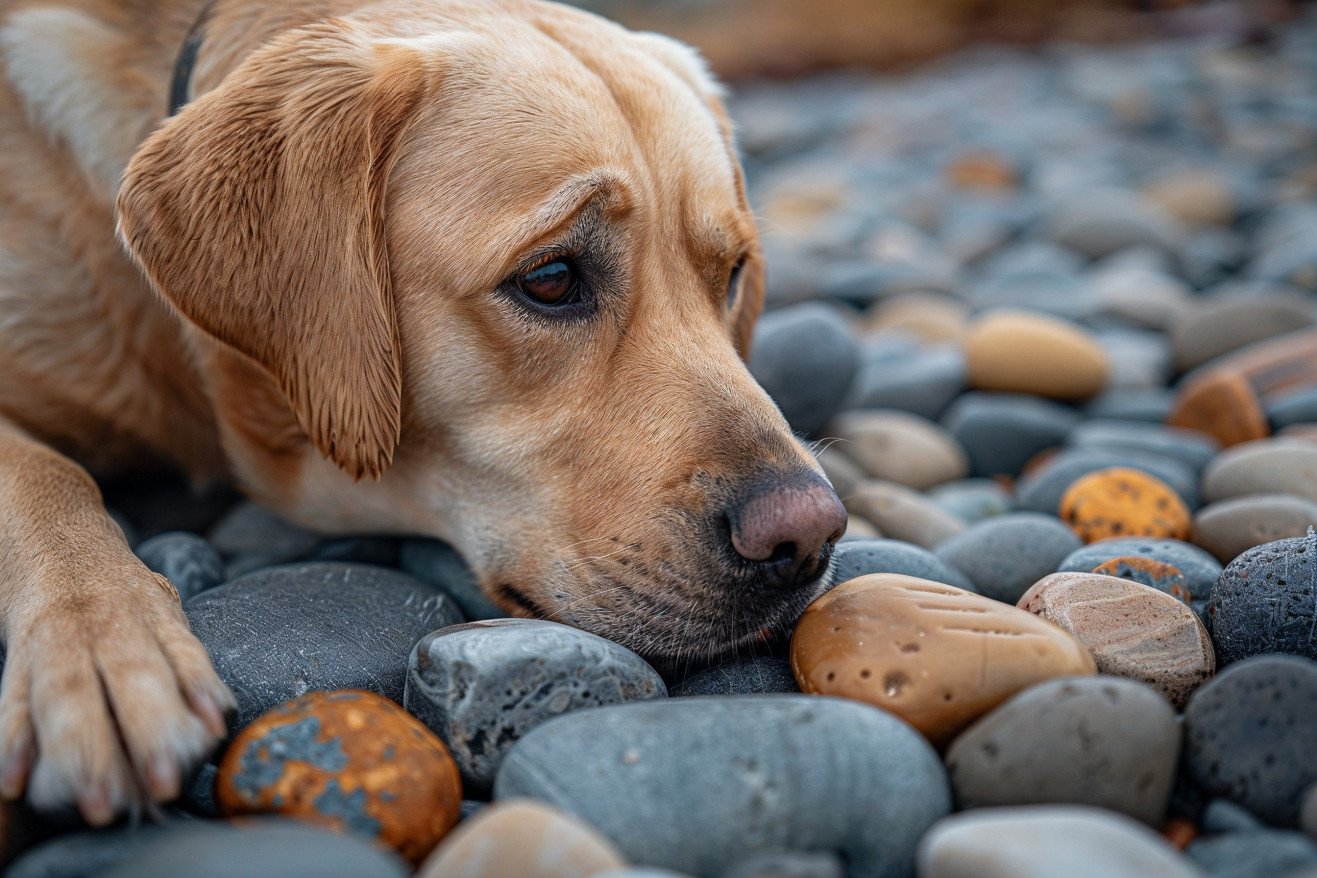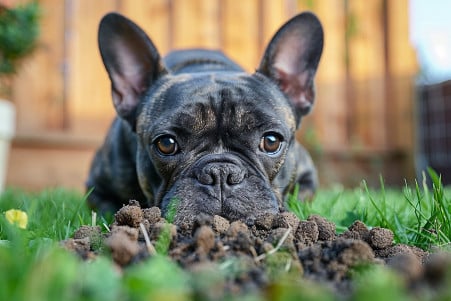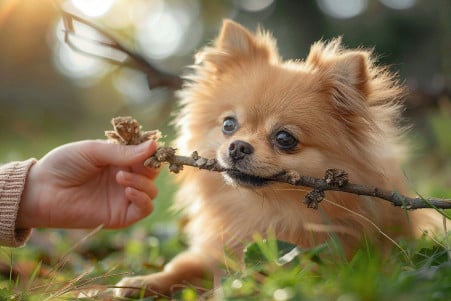Why Do Dogs Eat Rocks? Understanding This Risky Behavior
23 May 2024 • Updated 22 May 2024

While it may seem odd, dogs eating rocks can be a sign of a medical issue or a nutritional deficiency. Although it may not always be a sign that something is wrong, dogs may eat rocks because of pica (a condition that makes them crave and eat non-food items), gastrointestinal issues, boredom, or because they like the taste or texture of rocks.
To help you understand why your furry friend is eating rocks, this article will explore a number of scientific studies and insights from veterinarians. Together, their research reveals the causes, ways to prevent, and training methods to stop dogs from eating rocks. By learning more about this strange behavior, you can make sure your dog is as healthy and happy as possible.
Why do dogs eat rocks?
Pica in Dogs: The Compulsive Craving for Non-Food Items
Pica is a condition in which dogs eat non-food items such as rocks, dirt, or clothing. Causes, according to PetCube, include nutritional or hormonal imbalances, other medical conditions like diabetes, and genetics, with some breeds like Labrador retrievers being more likely to develop it. GoodRx adds that symptoms of pica can include vomiting, diarrhea, lethargy, and the presence of non-food items in the dog's stool.
Diagnosis requires ruling out other conditions with physical exams and other tests. As Wag Walking says, treatment will depend on the cause and can include dietary changes if the cause is a nutritional deficiency, behavior modification training if the cause is psychological, or the use of medication such as fluoxetine (Prozac) as suggested by VCA Hospitals in cases where the condition is life-threatening.
Medical Causes and Risk Factors of Dogs Eating Rocks
Nutritional deficiencies, like anemia or imbalances in minerals, can lead to an increase in a dog's consumption of non-food items, including rocks, says WagWalking. Meanwhile, certain medical problems, including gastrointestinal disorders, liver or pancreatic disease, and parasitic infections, can contribute to pica, which is defined as the persistent eating of non-nutritive substances, according to PetMD.
Puppies that are teething and dogs that are experiencing dental pain may eat rocks to help soothe their discomfort, says PawlicyAdvisor. Meanwhile, some dog breeds, including Labrador Retrievers, may be genetically predisposed to pica.
Early signs that a dog may be developing a habit of eating rocks include the observation of the behavior, vomiting, and the presence of rocks in the dog's stool, according to WagWalking. It's important to be able to identify these signs so that you can address the issue before it leads to more serious health problems.
Behavioral and Psychological Causes of Rock Eating
Boredom, lack of mental stimulation, and insufficient exercise can cause dogs to eat rocks due to curiosity or to relieve stress, according to the American Society for the Prevention of Cruelty to Animals (ASPCA). Anxiety, compulsive disorders, or a history of starvation or abuse can also lead to pica behaviors, according to Dogster.
If not corrected early on, dogs can learn to like the taste or texture of rocks, which can lead to pica, says Marthina McClay, a certified dog trainer at Dog Training for People. To help prevent behavioral pica, McClay recommends environmental enrichment, interactive toys, and regular exercise.
In cases of compulsive pica, a veterinary behaviorist may need to be consulted, according to the Best Friends Animal Society.
Potential Health Risks and Consequences of Rock Ingestion
Ingesting rocks can cause severe gastrointestinal problems such as blockages, perforations, or obstructions that may even require emergency surgery, according to Sundays for Dogs. It can also lead to dental issues, broken teeth, and wear and tear on a dog's teeth over time, according to Cuteness.
Ingesting certain rocks or large amounts of rocks can lead to toxicity or internal injuries, according to Dogster. Choking is also a concern, especially for smaller dogs or puppies that try to swallow larger rocks.
If pica and rock ingestion are not treated, they can lead to malnutrition, dehydration, and other long-term health issues. It is important to get your pet to the vet as soon as possible to treat rock ingestion and prevent more serious issues.
What Are the Best Ways to Prevent and Deal With Rock-Eating Behavior?
The first step in dealing with rock-eating behavior is to see a vet, who can help rule out any medical issues and make dietary recommendations to help with any nutritional deficiencies that may be contributing to the problem, according to Gotta Go Grass.
Training methods that use positive reinforcement, such as the 'drop it' and 'leave it' commands, can also be helpful in discouraging dogs from eating rocks, as explained by Wag! Training. Making sure your dog has plenty of appropriate chew toys, mental stimulation, and physical activity can also help reduce the boredom and anxiety that can lead to pica, according to the ASPCA.
Other management techniques include keeping a close eye on your dog when they're playing outside and regularly checking for rocks to remove any potential hazards, according to PetHelpful. In more extreme cases, you may need to use deterrents like muzzles or head collars to prevent your dog from eating rocks until you can correct the behavior, according to PetHelpful.
Conclusion: How to Keep Your Dog Safe and Healthy
While pica in dogs is not uncommon, it is a potentially life-threatening issue that should be taken seriously. Knowing the medical, behavioral, and psychological causes of pica is important in order to effectively treat the problem.
Early intervention, including veterinary treatment and behavioral training, can help to avoid serious health problems. It is also important to create a safe, stimulating environment and to address any other issues that may be contributing to the problem. With time and effort, dog owners can help their pets overcome pica and ensure that they live long, healthy, and happy lives.


